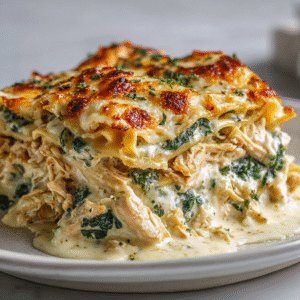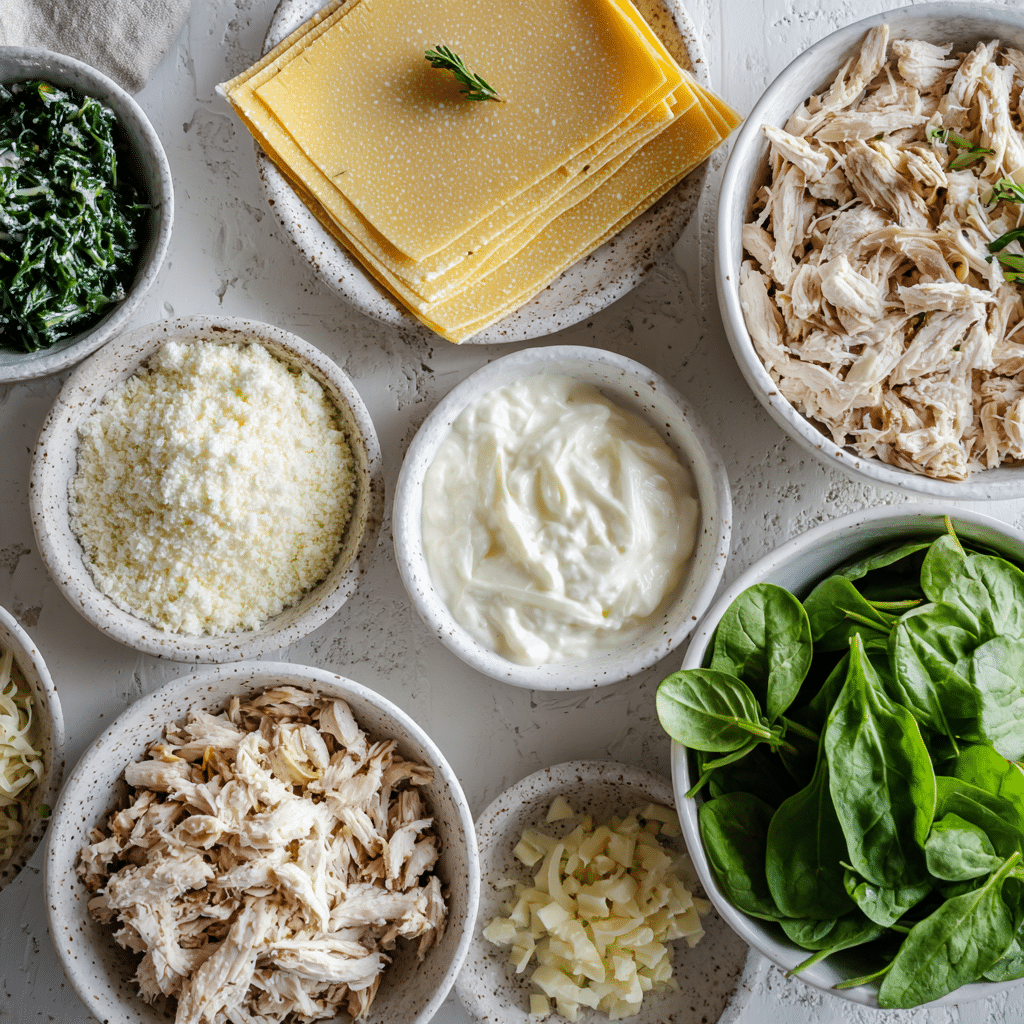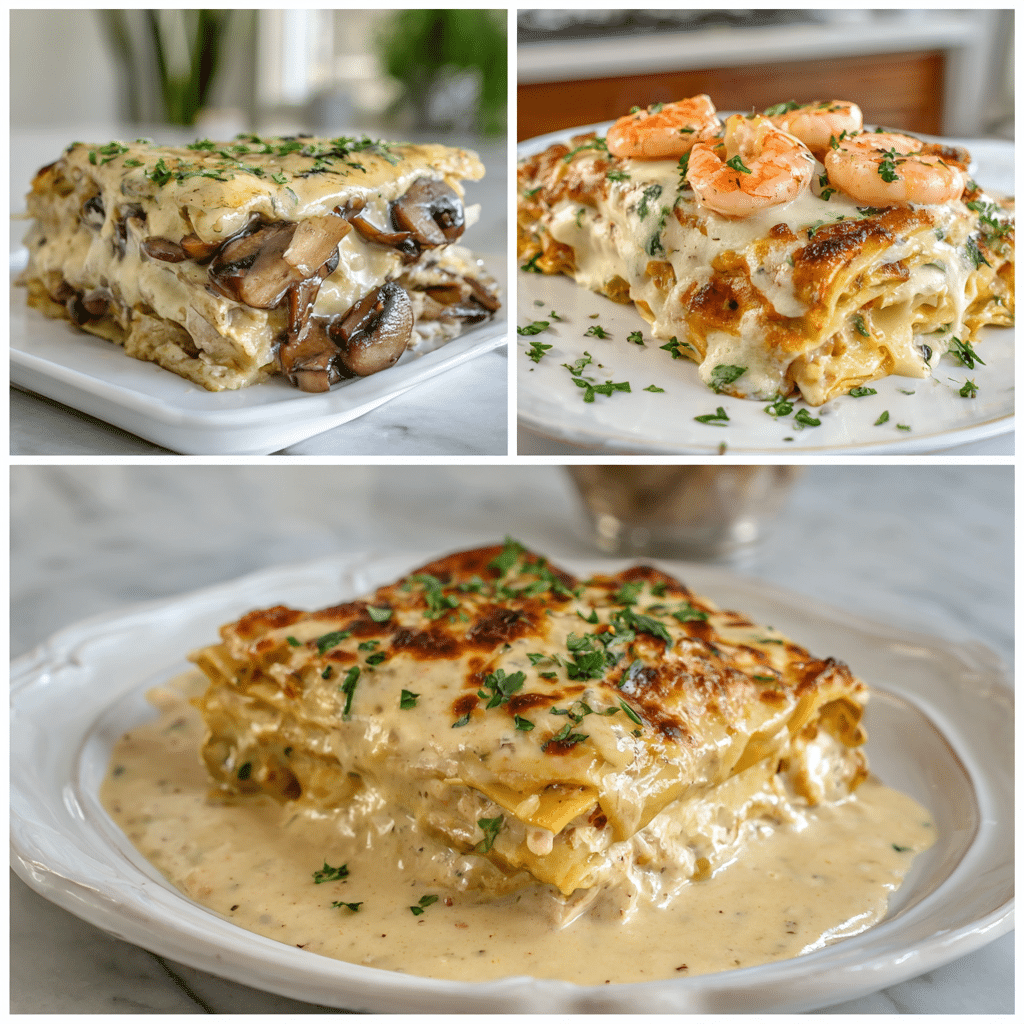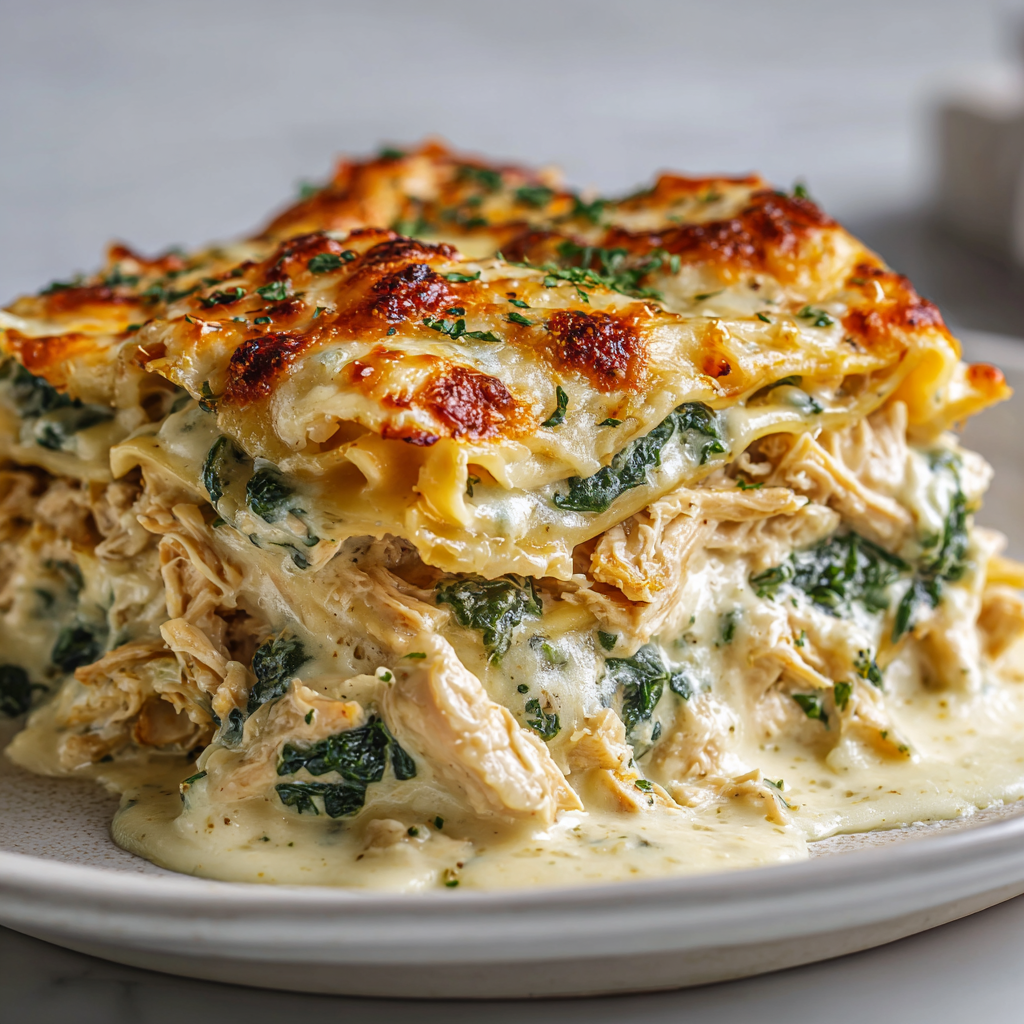Gluten Free Garlic Chicken Lasagna offers a satisfying alternative to traditional lasagna without compromising on flavor or texture. It combines tender shredded chicken with a rich garlic cream sauce and layers of gluten-free noodles, making it suitable for those with gluten sensitivities or dietary restrictions. This dish delivers the comforting experience of classic lasagna while accommodating gluten-free needs.
Table of Contents
The recipe also incorporates nutrient-rich ingredients like protein-packed chicken and vitamin-loaded spinach, resulting in a balanced meal that nourishes as well as satisfies. Its creamy texture and garlicky taste create a flavorful twist on a familiar favorite.
Ideal for weeknight dinners or special occasions, this lasagna is straightforward to prepare and serves as a versatile option for various diets. It blends convenience and health without sacrificing the essence of traditional Italian comfort food.

Gluten Free Garlic Chicken Lasagna
Ingredients
- 12 gluten-free lasagna noodles
- 2 tablespoons olive oil or butter
- 5 garlic cloves minced
- 3 cups shredded cooked chicken breast or thigh
- 1 teaspoon garlic powder
- Salt and black pepper to taste
- 1 cup cream cheese
- 1 cup milk dairy or plant-based
- 1 ½ cups ricotta cheese
- 2 cups shredded mozzarella cheese
- ½ cup grated Parmesan cheese
- 1 cup chopped spinach optional
- 2 tablespoons chopped fresh parsley or basil
Instructions
- Preheat the oven to 375°F (190°C).
- In a skillet, heat olive oil or butter and sauté minced garlic until fragrant.
- Add shredded chicken, garlic powder, salt, and pepper. Stir and set aside.
- In the same pan, melt cream cheese with milk over low heat until smooth. Add garlic salt if desired.
- Spread a thin layer of garlic sauce on the bottom of a baking dish.
- Layer as follows: noodles, garlic chicken, ricotta, mozzarella, Parmesan, and sauce. Repeat for three layers.
- Top with remaining cheese.
- Cover with foil and bake for 30-40 minutes.
- Remove foil and bake an additional 10 minutes until cheese is golden.
- Let rest for 10-15 minutes before slicing.
- Garnish with fresh herbs before serving.
Notes
Nutrition
What Is Gluten Free Garlic Chicken Lasagna?
Gluten Free Garlic Chicken Lasagna is a variation of traditional lasagna that omits gluten-containing ingredients while retaining rich flavors and creamy textures. It emphasizes lean chicken and garlic, combined with cheese and gluten-free pasta to create a wholesome, satisfying meal. This dish appeals to those with gluten sensitivities and anyone seeking alternative pasta options.
Dish Overview
This lasagna features layers of shredded or ground chicken cooked with garlic, combined with a creamy cheese mixture that often includes ricotta, mozzarella, and Parmesan. Rather than classic wheat-based noodles, it uses gluten-free lasagna sheets, made from rice, corn, or other gluten-free grains.
The garlic provides a distinct aromatic flavor that complements the mild chicken and creamy cheeses. Spinach or other vegetables can be added for extra nutrition and texture. The dish is usually baked until bubbly and golden, offering a rich, comforting meal without gluten.
Key Differentiators from Traditional Lasagna
The primary difference is the switch to gluten-free lasagna noodles, which maintain the pasta structure but use alternative flours like rice or corn. This change ensures the dish is safe for people with celiac disease or gluten intolerance.
The protein base shifts from the usual ground beef or pork to chicken, which creates a lighter overall flavor profile. Garlic is used more prominently for seasoning, often infused into the sauce or chicken, distinguishing it from heavily tomato-based lasagna recipes.
Additionally, the creamy sauce may incorporate cream cheese or béchamel alternatives to maintain moisture and richness without gluten-based thickeners.
Why Gluten Free?
Gluten-free variations address the needs of individuals with celiac disease, gluten intolerance, or wheat allergies. Consuming gluten can cause adverse reactions in these populations, so they require safe alternatives.
Using gluten-free noodles allows these individuals to enjoy familiar dishes without health risks. Additionally, some people choose gluten-free options for personal health reasons or dietary preferences, making this dish accessible to a broader audience.
By combining gluten-free pasta with lean chicken and garlic, the recipe balances dietary restrictions with flavor and nutrition.
Essential Ingredients for Gluten Free Garlic Chicken Lasagna

The recipe focuses on carefully selected gluten-free noodles, flavorful garlic and chicken, rich cheeses, and fresh herbs and vegetables. Each element combines to create a balanced dish that caters to gluten sensitivities while maintaining traditional lasagna appeal.
Gluten Free Lasagna Noodles
Gluten-free lasagna noodles are the foundation of this dish. They replace traditional wheat pasta to ensure the recipe is safe for those with gluten intolerance or celiac disease.
The best options include ready-to-use varieties like gluten-free Barilla oven-ready lasagna noodles or homemade rice and corn-based noodles. These provide structure without sacrificing texture. It’s important to check for noodles that won’t become overly soft or fall apart during baking.
Some gluten-free noodles require pre-cooking, while others can be layered dry. Following package instructions is essential to achieve the ideal consistency in the final dish.
Garlic and Chicken Selection
Garlic is a core flavor component, contributing aromatic warmth and more complex taste layers. Fresh garlic cloves, finely minced or pressed, deliver the strongest and most authentic flavor.
Chicken should be tender and shredded. Boneless, skinless chicken breasts or thighs can be poached, roasted, or slow-cooked before shredding. Some prefer store-bought rotisserie chicken for convenience without losing flavor.
Using high-quality, fresh ingredients here ensures the garlic’s pungency balances with the chicken’s mildness, forming the savory base of the lasagna.
Cheese and Dairy Components
Cheese blends in this lasagna offer creaminess and richness that balance the garlic’s sharpness and the noodles’ texture. Ricotta cheese is commonly used for creamy layers and binding.
Mozzarella adds stretchiness and meltiness, while parmesan imparts sharp, savory notes. Some recipes include cream cheese to create a smooth white sauce when combined with milk and garlic salt.
Choosing full-fat or part-skim dairy products depends on personal preference but impacts the final dish’s richness and texture. Proper layering of cheeses is necessary for flavor distribution and structural integrity.
Fresh Herbs and Vegetables
Fresh herbs like basil, parsley, and oregano elevate the flavor profile with bright, aromatic notes. These herbs complement the garlic and help balance the dish’s richness.
Vegetables such as spinach or garlic-infused spinach add nutritional value and a subtle earthiness. They also introduce moisture and color, making the lasagna visually appealing.
Incorporating finely chopped or sautéed vegetables ensures they blend well and do not release excess liquid, which could affect the lasagna’s texture.
Step-By-Step Preparation Guide
This recipe requires tender, well-seasoned chicken and a garlic-infused creamy sauce. The assembly demands alternating layers of sauce, chicken, cheese, and gluten-free noodles. Baking carefully ensures even cooking without drying the dish. Final steps add flavor and texture contrasts.
Prepping the Chicken and Garlic
Start by cooking chicken until tender, ideally using shredded chicken breast or thighs for texture. Season the chicken with salt, pepper, and garlic powder to build flavor early. Garlic is central—use fresh cloves minced finely or pressed to release aroma.
The garlic is then sautéed gently in butter or olive oil until fragrant but not browned. This base combines with cream cheese and milk to create a smooth white sauce. The sauce should be seasoned with garlic salt or additional minced garlic for a pronounced garlic flavor throughout the dish.
Assembling the Layers
Use gluten-free oven-ready lasagna noodles to avoid pre-boiling, which saves time and prevents breakage. Start with a thin layer of garlic sauce on the bottom of the baking dish to prevent sticking.
Layer the ingredients in this order: sauce, noodles, shredded garlic chicken, a blend of cheeses such as mozzarella and Parmesan, then repeat. Aim for at least three layers to balance moisture and texture. Spread each layer evenly for consistent cooking and flavor distribution.
Ensure the top layer is covered with a generous amount of cheese, which will brown and create a savory crust during baking.
Baking Techniques
Preheat the oven to 375°F (190°C). Cover the assembled lasagna with foil to trap steam, which helps cook the noodles and keep the dish moist.
Bake covered for 30 to 40 minutes, then remove the foil for the last 10 minutes to brown the cheese on top. Avoid opening the oven frequently to maintain even heat.
Once done, let the lasagna rest for 10 to 15 minutes before slicing. This allows the layers to set, making serving easier and cleaner.
Finishing Touches
Sprinkle fresh herbs such as chopped parsley or basil over the lasagna for color and a fresh contrast to the creamy garlic sauce.
Add a light drizzle of olive oil or a sprinkle of crushed red pepper flakes for a subtle kick if desired. Serving with a simple gluten-free salad or steamed vegetables complements the richness of the lasagna.
The dish is best served warm but can be refrigerated and reheated gently, keeping the flavors intact.
Choosing the Best Gluten Free Noodles
Selecting the right gluten-free noodles impacts both the flavor and texture of garlic chicken lasagna. Different pasta types offer varied cooking experiences and hold sauces differently. Texture affects how well the noodles layer and the overall mouthfeel, which is critical to a satisfying dish.
Popular Gluten Free Pasta Types
Rice-based noodles are common gluten-free options, known for their neutral flavor and firm texture once cooked. They are widely available and affordable.
Corn-based pasta offers a slightly sweet taste and tends to be more pliable, making it suitable for layering in lasagna.
Legume-based noodles, such as chickpea or lentil pasta, provide added protein and a denser texture. They may alter the flavor profile but increase nutritional value.
Some brands offer blends combining rice, quinoa, and corn for better texture and resistance to breaking during cooking. Oven-ready gluten-free lasagna sheets often use these blends to mimic traditional noodles without pre-boiling.
Texture and Taste Considerations
Texture is a key factor when choosing gluten-free noodles for lasagna. The noodles must remain firm but tender to support layering without falling apart. Some gluten-free noodles become mushy if overcooked, so brands with a sturdier texture are preferred.
Taste can vary significantly. Rice noodles tend to have a mild flavor, allowing the sauce and chicken to shine through. Corn and legume-based noodles may introduce a subtle earthiness or sweetness.
Balance between taste and texture helps create a cohesive dish, especially important for recipes like garlic chicken lasagna with rich, creamy sauces. Checking cooking instructions carefully reduces the risk of overcooking and preserves structure.
Flavor Enhancements and Variations
Adjusting protein types, accommodating dietary restrictions, and using distinctive spices or herbs can significantly change the character of gluten-free garlic chicken lasagna. These elements allow customization while maintaining the dish’s savory essence.
Alternative Proteins and Add-Ins
Chicken is the standard protein, but other options like turkey or lean pork can work well, maintaining a similar texture and flavor profile. For a seafood variation, white fish or shrimp layered between gluten-free noodles offers a lighter alternative.
Add-ins such as sautéed mushrooms, spinach, or roasted red peppers enhance texture and nutritional value. These vegetables pair well with the creamy garlic sauce and cheese blend, providing freshness and depth without overpowering the dish.
Dairy Free and Vegan Adjustments
For dairy-free or vegan diets, almond or cashew-based cream alternatives can replace cream cheese and milk in the sauce. Nutritional yeast serves as a substitute for cheese, adding a cheesy flavor without dairy.
To keep the protein content, tofu or tempeh can replace chicken. These plant-based options absorb garlic and seasoning effectively, preserving the dish’s savory qualities.
Spice and Herb Suggestions
Fresh herbs like basil, oregano, and thyme complement garlic and blend well into the sauce. Using rosemary or sage can add earthier notes, enhancing the complexity.
For mild heat, a pinch of red pepper flakes works without overwhelming the garlic flavor. Smoked paprika adds a subtle smokiness that deepens the overall taste.

Serving and Pairing Ideas
Gluten Free Garlic Chicken Lasagna pairs well with fresh, simple side dishes that balance the richness of the main dish. Beverages that complement its creamy, garlicky flavors enhance the dining experience effectively.
Side Dishes that Complement
A crisp garden salad with a light balsamic vinaigrette offers a refreshing contrast to the creamy lasagna. Vegetables like mixed greens, cherry tomatoes, and cucumbers keep the palate light.
Warm garlic bread made from gluten-free ingredients can accompany the meal, providing a crunchy texture alongside the soft lasagna layers.
Roasted or steamed vegetables such as asparagus, broccoli, or green beans add subtle earthiness and nutrition without overwhelming the flavors.
Simple sides that do not compete with the lasagna’s savory garlic sauce work best for a well-rounded plate.
Wine and Beverage Pairings
White wines with moderate acidity, like Sauvignon Blanc or Pinot Grigio, complement the creamy garlic sauce and chicken without overpowering delicate flavors.
A light Chardonnay, especially unoaked, matches well with the cheese and garlic without adding heaviness.
For non-alcoholic choices, sparkling water with a splash of lemon or a mild herbal iced tea refreshes the palate and balances richness.
Avoid heavy red wines that can clash with the creamy texture and garlic notes of the lasagna.
Storage and Reheating Tips
Proper storage and reheating are essential to maintain the texture and flavor of gluten-free garlic chicken lasagna. This ensures the dish stays safe to eat and tastes fresh even after being stored or reheated.
Make-Ahead and Freezing Instructions
Allow the lasagna to cool completely before storing. Cover tightly with plastic wrap or aluminum foil to prevent moisture loss and odor absorption.
For short-term storage, keep the lasagna in the refrigerator for up to 3-4 days. Use an airtight container or keep it in the baking dish covered securely.
To freeze, wrap the lasagna well in foil and place it in a freezer-safe container or bag. It is best consumed within 2-3 months. Label with the date to keep track. Thaw overnight in the fridge before reheating to ensure even warming.
Best Practices for Reheating
Reheat lasagna at a moderate temperature to avoid drying the dish out. Preheat the oven to 350°F (175°C). Cover with foil to keep moisture in and heat for about 20-25 minutes if refrigerated.
If frozen, reheat after thawing fully to maintain texture. For stovetop reheating, use low heat and cover the pan. Stir gently if needed, but avoid overmixing to preserve the layered structure.
Microwave reheating works in a pinch but should be done in short intervals with a cover to avoid drying. Stirring is not recommended for best results with layered dishes like lasagna.

